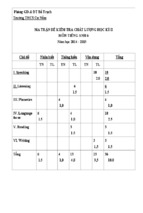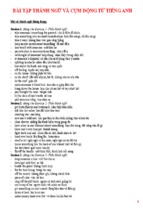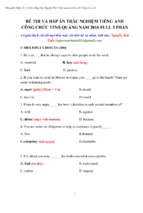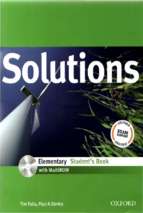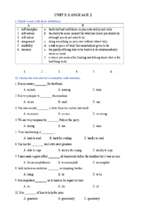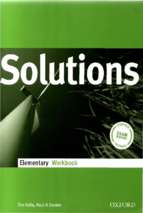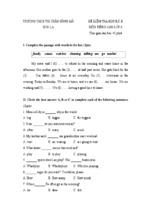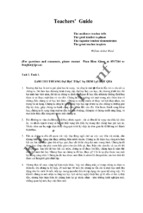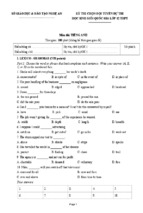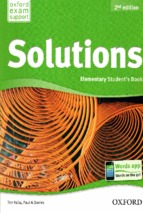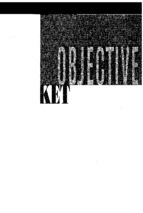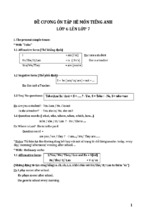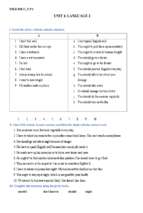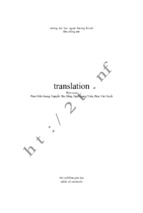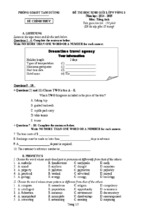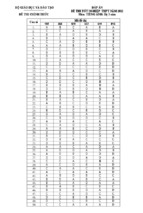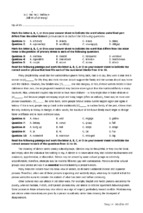PE2379 pr.qxd
24/1/02
16:02
Page v
PRONUNCIATION TABLE
Consonants
Vowels
Symbol Key word
Symbol
b
d
ù
dÔ
f
g
h
j
k
l
m
n
√
p
r
s
‹
t
t‹
�
v
w
z
Ô
back
day
then
jump
few
gay
hot
yet
key
led
sum
sun
sung
pen
red
soon
fishing
tea
cheer
thing
view
wet
zero
pleasure
ì
ëN
í
a∂
aÁ
a∂°
aÁ°
…N
…∂
…∂°
e
e°
e∂
e∂°
°
°Á
°Á°
§N
i
iN
∂
∂°
i°
uN
u
Á
Á°
î
Key word
bad
calm
pot British English
bite
now
tire
tower
caught
boy
employer
bed
there
make
player
about
note
lower
bird
pretty
sheep
ship
here
alien
boot
actuality
put
poor
cut
/ `/ shows main stress
/ˇ / shows secondary stress
/r/ at the end of a word means that /r/ is usually pronounced in American
English and is pronounced in British English when the next word
begins with a vowel sound
/°∂ / means that some speakers use /∂ / and others use /° /
/ Á° / means that some speakers use /Á/ and others use /°/
/ i/ means many American speakers use /iN/ but many British speakers use
/∂ /
/u/ represents a sound somewhere between /uN/ and /Á/
/�/ means that /°/ may or may not be used
/�/ shows stress shift
Thuvientailieu.net.vn
PE2379 pr.qxd
24/1/02
16:02
Page vi
GUIDE TO THE DICTIONARY
related word
less common
alternative
part of speech
aphasia n aphasic adj
also dysphasia n
loss of the ability to use and understand language, usually caused
by damage to the brain. The loss may be total or partial, and may
affect spoken and/or written language ability.
There are different types of aphasia: agraphia is difficulty in writing;
alexia is difficulty in reading; anomia is difficulty in using proper
nouns; and agrammatism is difficulty in using grammatical words
like prepositions, articles, etc.
Aphasia can be studied in order to discover how the brain
processes language.
other related
see also BRAIN, NEUROLINGUISTICS
entries it
may be
useful to
look up
computer assisted language learning
also CALL
the use of a computer in the teaching or learning of a second or
abbreviation
foreign language. CALL may take the form of
for term
a activities which parallel learning through other media but which
use the facilities of the computer (e.g. using the computer to
present a reading text)
b activities which are extensions or adaptations of print-based or
classroom based activities (e.g. computer programs that teach
writing skills by helping the student develop a topic and THESIS
STATEMENT and by checking a composition for vocabulary,
grammar, and topic development), and
c activities which are unique to CALL.
See also INTERACTIVE VIDEO
entry for a
less
common
alternative
dysphasia n
another term for
entry for an
abbreviation
CALL n
an abbreviation for
entry for a
word
explained
elsewhere
agrammatism n
see APHASIA
APHASIA
COMPUTER ASSISTED LANGUAGE LEARNING
Thuvientailieu.net.vn
terms
explained
within the
entry
term
explained at
its own
alphabetical
entry
PE2379 pr.qxd
24/1/02
16:02
Page vii
INTRODUCTION
Who is this dictionary for?
This dictionary is intended for:
• students taking undergraduate or graduate courses in language teaching or applied linguistics, particularly those planning to take up a
career in the teaching of English as a Second or Foreign Language or in
foreign language teaching
• language teachers doing in-service or pre-service courses, such as the
UCLES Diploma in Teaching English to Adults
• students doing introductory courses in linguistics and related areas
• teachers and others interested in the practical applications of language
study
Why this dictionary?
Language teaching and applied linguistics are fields which have their own
core subject matter and which also draw on a number of complementary
fields of study. Among the core subject matter disciplines are second language acquisition, methodology, testing, and syllabus design. The complementary fields of study include both the language based disciplines such
as linguistics, sociolinguistics, and psycholinguistics, as well as the education based disciplines such as curriculum development, teacher education, and evaluation. The result is that students taking courses in
language teaching and applied linguistics encounter a large number of
specialized terms which frequently occur in articles, books and lectures.
This dictionary attempts to clarify the meanings and uses of these terms.
The scope of the dictionary
The dictionary was written for those with little or no background in language teaching or applied linguistics.
We have given special attention to English, and the majority of the
examples in the dictionary are from English, but the dictionary will also
be helpful to those interested in other languages. Although the dictionary
is not intended primarily for those who already have a specialized training in language teaching or applied linguistics, it will serve as a reference
book in areas with which they are less familiar. It should also be useful to
vii
Thuvientailieu.net.vn
PE2379 pr.qxd
24/1/02
16:02
Page viii
Introduction
general readers who need further information about the terms which
occur in the fields of language teaching and applied linguistics.
Language teaching and applied linguistics
This dictionary includes the core vocabulary of both language teaching
and applied linguistics. The field of language teaching is concerned with
the development of language programmes and courses, teaching methodology, materials development, second language acquisition theory, testing, teacher training and related areas. The dictionary includes terms from
the following areas of study in the field of language teaching:
•
•
•
•
•
•
•
•
teaching methods and approaches in language teaching
curriculum development and syllabus design
second language acquisition
the teaching of listening, speaking, reading and writing
computer assisted language learning
teacher education in language teaching
English grammar and pronunciation
language testing, research methods, and basic statistics
The dictionary also includes terms from the field of applied linguistics.
For the purposes of this book, “applied linguistics” refers to the practical
applications of linguistics and language theory and includes terms from
the following areas of study:
• introductory linguistics, including phonology, phonetics, syntax,
semantics and morphology
• discourse analysis
• sociolinguistics, including the sociology of language and communicative competence
• psycholinguistics, including learning theories
What the dictionary contains
This dictionary contains 2800 entries which define, in as simple and precise a way as possible, the most frequently occurring terms found in the
areas listed above. Many of these terms were included in the second
edition of this dictionary, but the third edition includes some 800 terms
not included in the second edition as well as revisions of many of the
entries in the second edition. Each term has been selected on the basis of
its importance within an area and reflects the fact that the term has a particular meaning when used within that area, a meaning unlikely to be
listed in other dictionaries.
viii
Thuvientailieu.net.vn
PE2379 pr.qxd
24/1/02
16:02
Page ix
Introduction
Our aim has been to produce clear and simple definitions which communicate the basic and essential meanings of a term in non-technical language. Definitions are self-contained as far as possible, but cross
references show links to other terms and concepts.
Acknowledgements
We would like to thank those colleagues from institutions around the
world who contributed to the preparation of the first and second editions
of this dictionary, giving advice on items for inclusion and providing
comments on individual entries.
This edition of the dictionary has been prepared by Jack C. Richards and
Richard Schmidt. We would like to thank the following for their assistance in the preparation of this edition:
Youngkyu Kim for assistance in the area of testing, research design, and
statistics.
Ken Hyland and Stephen Jacques for suggestions for items for inclusion.
Graham Crookes for comments on entries.
We would also like to thank those who contributed to earlier editions of
this dictionary, particularly Heidi Kendricks, who contributed to the first
and second editions, the late John Platt, who contributed to the first and
second editions, and to the following who gave valuable suggestions to
earlier editions: Christopher Candlin, John W. Oller (Jr), Lyle Bachman.
ix
Thuvientailieu.net.vn
PE2379 pr.qxd
24/1/02
16:02
Page x
Thuvientailieu.net.vn
PE2379 ch01.qxd
24/1/02
16:03
Page 1
A
AAE n
another term for
AFRICAN AMERICAN ENGLISH
AAVE n
an abbreviation for AFRICAN AMERICAN
see AFRICAN AMERICAN ENGLISH
VERNACULAR ENGLISH
ability grouping n
in teaching, the placement of students in groups or classes according to
their ability in a skill or subject, e.g. based on their language proficiency.
Groups containing students of different ability levels are known as mixed
ability groups or heterogeneous groups, while groups composed of students with similar abilities, achievement, etc., are known as homogeneous
groups. See GROUPING
ablaut n
a process by which an inflected form of a word is formed by changes in
the vowel of the stem. For example, the past tense of sing is sang and the
plural of goose is geese.
absolute n
an adjective or adverb that cannot have a comparative or superlative
form. For example perfectly and unique already express the idea of “to a
maximum degree” and cannot therefore be used with comparative forms
as in *most perfectly, or *more unique.
absolute clause (phrase, construction) n
a non-finite adverbial clause or other adverbial construction that is not
linked syntactically to the main clause, e.g.
As far as I can tell, she is not having any problems with the course.
abstract noun n
see CONCRETE
NOUN
ABX discrimination n
in PSYCHOLINGUISTICS, a task in which three stimuli are presented in a
trial. A and B are different (for example, the words ramp and lamp) and
the subject’s task is to choose which of them is matched by the final
stimulus.
1
Thuvientailieu.net.vn
PE2379 ch01.qxd
24/1/02
16:03
Page 2
academic language
academic language n
the special registers and genres of language used in the learning of academic subject matter in formal schooling contexts. Mastery of academic language is associated with literacy and academic achievement
and involves learning specific terms, text types, discourse features and
speech registers in different fields of study (e.g. history, maths).
Learning academic language is essential for mainstreaming for second
language learners and for students studying English for Academic
Purposes.
academic vocabulary n
the most frequently occurring vocabulary in academic texts. In English a
core academic vocabulary of some 600 words (e.g. words such as evidence, estimate, feature, impact, method, release,) is common to a wide
range of academic fields and accounts for around 10% of the words in
any academic text. Students need to be familiar with this vocabulary if
they are to complete academic courses successfully. The teaching of academic vocabulary is an aspect of English for Academic Purposes.
Academic vocabulary is determined from analysis of a corpus of academic
English. Academic Vocabulary may be compared with Technical
Vocabulary, which refers to words specific to a particular topic, field or
discipline.
accent1 n
greater emphasis on a syllable so that it stands out from the other
syllables in a word. For example, in English the noun `import has the
accent on the first syllable im- while the verb im`port has the accent on the
second syllable -port:
This car is a foreign import.
We import all our coffee.
see also PROMINENCE, STRESS
accent2 n
in the written form of some languages, particularly in French, a mark
which is placed over a vowel. An accent may show:
a a difference in pronunciation (see DIACRITIC).
For example, in the French word prés “meadows”, the acute accent on
the e indicates a different vowel sound from that in près “near” with a
grave accent.
b a difference in meaning without any change in pronunciation, e.g.
French ou “or” and où “where”.
2
Thuvientailieu.net.vn
PE2379 ch01.qxd
24/1/02
16:03
Page 3
acceptable
accent3 n
a particular way of speaking which tells the listener something about the
speaker’s background.
A person’s pronunciation may show:
a the region or country they come from, e.g.
a northern accent
an American accent
b what social class they belong to, e.g.
a lower middle class accent
c whether or not the speaker is a native speaker of the language, e.g.
She speaks English with an accent/with a German accent.
see also DIALECT, SOCIOLECT
accent4 n
another term for
STRESS
accent discrimination
discrimination or bias against speakers with foreign, regional, or social
class ACCENTS3, for example in employment or in legal proceedings.
see also FORENSIC LINGUISTICS
accent reduction n
programmes designed to help second language speakers speak a
second or foreign language without showing evidence of a
foreign accent. Such programmes reflect the fact that many second
language speakers experience discrimination based on their
accent. There is no evidence however that reduction in a
foreign accent necessarily entails an increase in intelligibility.
Hence many educators argue for a greater tolerance of foreign accents.
See also English as an International Language
acceptable adj
(in linguistics) the judgement by the native speakers/users of a speech variety that a certain linguistic item is possible in their variety. The linguistic
item could be a written sentence, a spoken utterance, a particular syntactic structure, a word or a way of pronouncing a certain sound. The speech
community where such an item is considered acceptable could be all the
speakers of a particular region or social class or, alternatively, just the
members of an in-group, for example teenagers belonging to a rock club
who have created their own in-language. A linguistic item which is
acceptable to one group or variety need not be acceptable to another, for
example, speakers of some varieties of English accept such expressions as:
3
Thuvientailieu.net.vn
PE2379 ch01.qxd
24/1/02
16:03
Page 4
acceptable alternative method
I want for him to come.
and
We were visiting with (meaning “calling on”) Aunt Lizzie. but speakers of other varieties would not accept these expressions and use instead:
I want him to come.
and
We were visiting Aunt Lizzie.
Sometimes linguistic items are acceptable in certain situations and not in
others. For example a teenager may tell a friend:
I nearly freaked out when I saw that jerk. and in that situation it would
be acceptable. It would usually be unacceptable if the utterance was used
in a formal address at a special function (except, of course, if it was said
jokingly).
The terms acceptable and unacceptable are different from grammatical
(see GRAMMATICAL1) as they cover a wider range of linguistic units and
situations. And because they do not have prescriptive overtones (see
PRESCRIPTIVE GRAMMAR) they are also preferred to expressions such as
CORRECT/INCORRECT, SUBSTANDARD, right/wrong.
see also APPROPRIATENESS, CONVERSATIONAL RULES
acceptable alternative method n
see CLOZE TEST
acceptable word method n
see CLOZE TEST
acceptability judgement task n
one of several types of tasks (or tests) that require subjects to judge
whether particular sentences are possible or not in either their native language or a language they are learning. If the task instructions specify that
subjects are to judge whether or not a sentence is acceptable, the task is
called an acceptability judgement task; if they are asked to judge whether
a particular sentence is grammatical, the task is usually called a grammaticality judgement task (or test).
access n, v
in COMPUTER ASSISTED LANGUAGE LEARNING, locating or obtaining information or data. Sequential access means locating information in
sequence, for example by fast forwarding an audio cassette. Direct access
or random access means locating information directly, in such a way that
access time is not dependent on its location.
4
Thuvientailieu.net.vn
PE2379 ch01.qxd
24/1/02
16:03
Page 5
accredited interpreter
accidental gap n
in WORD FORMATION, a non-occurring but possible form, for example
unsad as an ANTONYM of sad. When learners produce such forms, these
are considered to be examples of OVER-GENERALIZATION.
accommodation1 n
a theory that seeks to explain shifts in the style of speaking people make such
as when a person changes their way of speaking to make it sound more like
or less like the speech of the person they are talking to. For example, a teacher
may use simpler words and sentence structures when he/she is talking to a
class of young children. This is called convergence. Alternatively a person
may exaggerate their rural accent because they are annoyed by the attitude
of someone from the city. This is called divergence. Convergence is a strategy in which people adapt to each other’s speech by adjusting such things as
speech rate, pauses, length of utterance, and pronunciation. Divergence
involves emphasizing speech and non-verbal differences between the
speaker and other interlocutors. In communication between native and nonnative speakers or between second language speakers with different levels of
proficiency, accommodation may serve to promote intelligibility.
see also ACCENT3
accommodation2 n
see ADAPTATION2
accomplishments n
see ASPECT
accountability n
the answerability of all those involved in applied linguistics for the quality of their work. For example, test developers need to be able to explain
the rationale behind the assessment techniques they use and their results
to test takers and test users; language programme administrators are
accountable to clients who pay for special courses, as well as to students
for the quality of instruction; and public school programme administrators are accountable to parents and other members of the public.
Accountability includes the documentation and reporting of procedures
used to develop curriculum and courses and of practices used in the hiring
of teachers, selection of materials, evaluation of teachers and courses and
the assessment of learners and learning outcomes.
accredited interpreter n
see INTERPRETATION
5
Thuvientailieu.net.vn
PE2379 ch01.qxd
24/1/02
16:03
Page 6
accredited translator
accredited translator n
see TRANSLATION
acculturation n
a process in which changes in the language, culture, and system of values of
a group happen through interaction with another group with a different language, culture, and system of values. For example, in second language learning, acculturation may affect how well one group (e.g. a group of immigrants
in a country) learn the language of another (e.g. the dominant group).
see also ACCULTURATION MODEL ASSIMILATION2, SOCIAL DISTANCE
acculturation model n
in second language acquisition, the theory that the rate and level of ultimate success of second language acquisition in naturalistic settings (without instruction) is a function of the degree to which learners acculturate
to the target language community. Acculturation may involve a large
number of social and psychological variables, but is generally considered
to be the process through which an individual takes on the beliefs, values
and culture of a new group.
accuracy n
see FLUENCY
accuracy order n
also difficulty order
some linguistic items, forms, and rules seem to be consistently produced
with higher accuracy than others by language learners, permitting such
items to be ordered with respect to their relative difficulty. Accuracy
orders based on CROSS-SECTIONAL RESEARCH are sometimes taken as evidence for an order of acquisition, although such claims need to be reinforced through LONGITUDINAL RESEARCH.
accusative case n
the form of a noun or noun phrase which shows that it functions as the
direct object of the verb in a sentence. For example, in the German sentence:
Ursula kaufte einen neuen Tisch.
Ursula bought a
new table.
in the noun phrase einen neuen Tisch, the article ein and the adjective
neu have the inflectional ending -en to show that the noun phrase is in
the accusative case because it is the direct object of the verb.
see also CASE1
6
Thuvientailieu.net.vn
PE2379 ch01.qxd
24/1/02
16:03
Page 7
acquisition order
achievement test n
a test designed to measure how much of a language learners have successfully learned with specific reference to a particular course, textbook,
or programme of instruction, thus a type of CRITERION-REFERENCED TEST.
An achievement test is typically given at the end of a course, whereas
when administered periodically throughout a course of instruction to
measure language learning up to that point, it is alternatively called a
PROGRESS TEST. Its results are often used to make advancement or graduation decisions regarding learners or judge the effectiveness of a
programme, which may lead to curricular changes.
The difference between this and a more general type of test called a PROFICIENCY TEST is that the latter is not linked to any particular course of
instruction and is thus a type of NORM-REFERENCED TEST. For example, an
achievement test might be a listening comprehension test if all of its items
are based on a particular set of dialogues in a textbook. In contrast, a proficiency test might use similar test items but would not be linked to any
particular textbook or language SYLLABUS.
achievements n
see ASPECT
acoustic cue n
an aspect of the acoustic signal in speech which is used to distinguish
between phonetic features. For example VOICE ONSET TIME is an acoustic
cue which is used to distinguish between the sounds /t/ and /d/
acoustic filtering n
(in listening comprehension) the ability to hear and identify only some of
the sounds that are being spoken. For example, when someone is learning a foreign language, the speech sounds of their native language may act
as a filter, making it difficult for them to hear and identify new or unfamiliar sounds in the foreign language.
acoustic phonetics n
see PHONETICS
acquisition n
see FIRST
LANGUAGE ACQUISITION, LANGUAGE ACQUISITION, SECOND LAN-
GUAGE ACQUISITION
acquisition order n
another term for
ORDER OF ACQUISITION
7
Thuvientailieu.net.vn
PE2379 ch01.qxd
24/1/02
16:03
Page 8
acrolect
acrolect n
see POST-CREOLE
CONTINUUM, SPEECH CONTINUUM
acronym n
a word made from the initials of the phrase it stands for, for example
“IPA” for International Phonetics Association or International Phonetics
Alphabet.
ACT* (pronounced “act-star”)
see ADAPTIVE CONTROL OF
THOUGHT
ACTFL Proficiency Guidelines n
proficiency descriptions developed under the auspices of the American
Council on the Teaching of Foreign Languages (ACTFL). Since their latest
revision in 1996, the guidelines consist of descriptions of ten proficiency
levels: Novice Low, Novice Mid, Novice High, Intermediate Low,
Intermediate Mid, Intermediate High, Advanced Low, Advanced Mid,
Advanced High, and Superior.
ACTFL Oral Proficiency Interview n
also OPI
a structured interview carried out to assess a learner’s ability to use the
target language in terms of the levels described by the ACTFL PROFICIENCY
GUIDELINES, used as an assessment of speaking proficiency.
action research n
1 research that has the primary goal of finding ways of solving problems,
bringing about social change or practical action, in comparison with
research that seeks to discover scientific principles or develop general
laws and theories.
2 (in teacher education) teacher-initiated classroom research that seeks
to increase the teacher’s understanding of classroom teaching and
learning and to bring about improvements in classroom practices.
Action research typically involves small-scale investigative projects in
the teacher’s own classroom, and consists of the following cycle of
activities:
a The teacher (or a group of teachers) selects an aspect of classroom
behaviour to examine in more detail (e.g. the teacher’s use of questions)
b selects a suitable research technique (e.g. recording classroom lessons)
c collects data and analyzes them
d develops an action plan to help bring about a change in classroom
8
Thuvientailieu.net.vn
PE2379 ch01.qxd
24/1/02
16:03
Page 9
adaptation
behaviour (e.g. to reduce the frequency of questions that the teacher
answers himself or herself)
e acts to implement the plan
f observes the effects of the action plan on behaviour
active/passive language knowledge n
also productive receptive language knowledge
the ability of a person to actively produce their own speech and writing is
called their active language knowledge. This is compared to their ability
to understand the speech and writing of other people, their passive language knowledge.
Native speakers of a language can understand many more words than
they actively use. Some people have a passive vocabulary (i.e. words they
understand) of up to 100,000 words, but an active vocabulary (i.e. words
they use) of between 10,000 and 20,000 words.
In foreign language learning, an active vocabulary of about 3000 to 5000
words, and a passive vocabulary of about 5000 to 10,000 words is
regarded as the intermediate to upper intermediate level of proficiency.
active teaching n
another term for
DIRECT TEACHING
active vocabulary n
see ACTIVE/PASSIVE
LANGUAGE KNOWLEDGE
active voice n
see voice1
activities n
see ASPECT
acute accent n
the accent`, e.g. on French prés “meadows”.
see also ACCENT2
ad hoc interpreting n
informal translation of spoken interaction, for example during social
events or business meetings
see also INTERPRETATION
adaptation1 n
changes made in the use of published teaching materials in order to make
9
Thuvientailieu.net.vn
PE2379 ch01.qxd
24/1/02
16:03
Page 10
adaptation
them more suitable for particular groups of learners, e.g. by supplementing, modifying or deleting parts of a textbook.
adaptation2 n
also equilibration
in Piagetian theory, a cover term for two ways in which a child adapts to
his or her environment: assimilation3, interpreting new information in
terms of the child’s current knowledge, and accommodation2, changing
the child’s cognitive structure to understand new information.
adaptive control of thought n
also ACT*
a model of skill learning, involving a progression from a controlled
stage based on DECLARATIVE KNOWLEDGE to an autonomous stage based
on PROCEDURAL KNOWLEDGE. Processes involved in this development
include proceduralization (the translation of propositional knowledge
into behavioural sequences, chunking (the binding together of commonly occurring units, which allows more information to be maintained in WORKING MEMORY), GENERALIZATION, rule narrowing, and rule
strengthening. Language acquisition is seen in this model as a type of
skill learning.
adaptive testing n
a form of individually tailored testing in which test items are selected
from an ITEM BANK where test items are stored in rank order with respect
to their ITEM DIFFICULTY and presented to test takers during the test on the
basis of their responses to previous test items, until it is determined that
sufficient information regarding test takers’ abilities has been collected.
For example, when a multiple-choice adaptive vocabulary test is administered, a test taker is initially presented with an item of medium difficulty.
If he or she answers it correctly, then a slightly more difficult item is presented, whereas if the item is answered incorrectly, then a slightly easier
item is presented. An ORAL PROFICIENCY INTERVIEW can be viewed as a type
of adaptive testing in the sense that an interviewer (i.e. tester) adjusts the
difficulty level of language on the basis of an evolving assessment of the
interviewee’s (i.e. test taker’s) language ability. Adaptive testing finds its
most promising application in COMPUTER ADAPTIVE TESTING.
additive bilingual education n
also additive bilingualism
a form of BILINGUAL EDUCATION in which the language of instruction is not
the mother tongue or home language of the children, and is not intended
10
Thuvientailieu.net.vn
PE2379 ch01.qxd
24/1/02
16:03
Page 11
adjacency pair
to replace it. In an additive bilingual education programme the first language is maintained and supported.
For example, the bilingual programmes in French for English-speaking
Canadians are intended to give the children a second language, not to
replace English with French.
When the language of instruction is likely to replace the children’s first
language, this is called subtractive bilingualism.
see also IMMERSION PROGRAMME
address form n
also address term, form/term of address
the word or words used to address somebody in speech or writing. The
way in which people address one another usually depends on their age,
sex, social group, and personal relationship.
For example, many languages have different second person pronoun
forms which are used according to whether the speaker wants to address
someone politely or more informally, e.g. in German Sie – du, in French
vous – tu, in Spanish usted – tu and in Mandarin Chinese nín – nı̌ (you).
If a language has only one second person pronoun form, e.g. English you,
other address forms are used to show formality or informality, e.g. Sir, Mr
Brown, Brown, Bill. In some languages, such as Chinese dialects and
Japanese, words expressing relationship, e.g. father, mother, aunt, or position, e.g. teacher, lecturer, are used as address forms to show respect
and/or signal the formality of the situation, for example:
Mandarin Chinese: bàba
qı̌ng c̄hı̌
father please eat!
Japanese:
sensei
dozo! (a polite request)
teacher/sir please!
The address forms of a language are arranged into a complex address
system with its own rules which need to be acquired if a person wants
to communicate appropriately.
see also COMMUNICATIVE COMPETENCE
address system n
see ADDRESS
FORM
address term n
see ADDRESS
FORM
adjacency pair n
a sequence of two related utterances by two different speakers. The
second utterance is always a response to the first.
11
Thuvientailieu.net.vn
PE2379 ch01.qxd
24/1/02
16:03
Page 12
adjacency parameter
In the following example, speaker A makes a complaint, and speaker B
replies with a denial:
A: You left the light on.
B: It wasn’t me!
The sequence of complaint – denial is an adjacency pair. Other examples
of adjacency pairs are greeting – greeting, question – answer, invitation –
acceptance/non-acceptance, offer – acceptance/non-acceptance, complaint – apology.
Adjacency pairs are part of the structure of conversation and are studied
in CONVERSATIONAL ANALYSIS.
adjacency parameter n
(in GOVERNMENT/BINDING THEORY) one of the conditions (PARAMETERS)
which may vary from one language to another.
For example, English requires that the element in the sentence which
“assigns” the case (see CASE ASSIGNER) has to be next (adjacent) to the
noun phrase that receives the case, e.g.:
him very much.
She
liked
verb
noun phrase
(case assigner) (object case)
but not:
*She liked very much him.
Other languages, such as French, do not have this restriction:
J’aime beaucoup la France.
In second language acquisition research, investigations have been made
into this variation of the adjacency condition. For example, how do
native speakers of French, which has a [-adjacency] parameter, deal with
a language which has a [+adjacency] parameter, such as English? Do they
transfer their native [-adjacency] condition into English or not?
see also PRO-DROP PARAMETER
adjacency principle n
in some linguistic theories, the concept that two syntactic constituents
must be next (adjacent) to each other and cannot be separated by other
constituents.
For example, in English, a noun phrase (NP) complement must be adjacent
to its verb, e.g.:
She threw the parcel into the car
verb NP complement
but not:
*She threw into the car the parcel
verb
NP complement
see also ADJACENCY PARAMETER
12
Thuvientailieu.net.vn
PE2379 ch01.qxd
24/1/02
16:03
Page 13
adjunct
adjectival noun n
an adjective used as a noun, e.g. the poor, the rich, the sick, the old.
see also SUBSTANTIVE
adjective n
a word that describes the thing, quality, state, or action which a noun
refers to. For example black in a black hat is an adjective. In English,
adjectives usually have the following properties:
a they can be used before a noun, e.g. a heavy bag
b they can be used after be, become, seem, etc. as complements, e.g. the
bag is heavy
c they can be used after a noun as a complement, e.g. these books make
the bag heavy
d they can be modified by an adverb, e.g. a very heavy bag
e they can be used in a comparative or superlative form, e.g. the bag
seems heavier now
see also COMPLEMENT, COMPARATIVE, ATTRIBUTIVE ADJECTIVE
adjective complement n
see COMPLEMENT
adjective phrase n
a phrase that functions as an adjective. For example,
The woman in the corner is from Italy.
adjunct n
may be classified as adjuncts, conjuncts, or disjuncts. An
adjunct is part of the basic structure of the clause or sentence in which it
occurs, and modifies the verb. Adverbs of time, place, frequency, degree,
and manner, are examples of adjuncts.
He died in England.
I have almost finished.
Conjuncts are not part of the basic structure of a clause or sentence. They
show how what is said in the sentence containing the conjunct connects
with what is said in another sentence or sentences.
Altogether it was a happy week.
However the weather was not good.
Disjuncts (also called sentential adverbs) are adverbs which show the
speaker’s attitude to or evaluation of what is said in the rest of the sentence.
Naturally, I paid for my own meal.
I had to pay for my own meal, unfortunately
see also ADVERB
ADVERBIALS
13
Thuvientailieu.net.vn
- Xem thêm -

